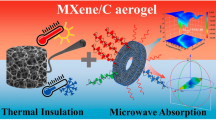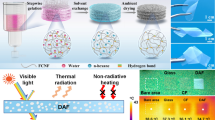Abstract
Carbon materials are commonly used in the solar steam generation because they can absorb broadband light and generate heat effectively. However, conventional carbon with a smooth surface is limited by a moderate reflection of approximately 10%, causing significant reflective energy loss. Thus, we proposed a nanoscale multiple interface strategy to boost the intrinsic light absorption of carbon nanofibers (CNFs) for more efficient solar-driven water purification. The multiple interfaces were constructed by introducing hierarchical nanopores in CNFs (HPCNFs) through a facile sacrificial framework method. Owing to the high surface roughness and abundant internal air-dielectric interfaces derived from the hierarchical pores, the HPCNFs show significant improvement in broadband light (300–2500 nm) absorption up to 97.62%, which enables high solar-vapor conversion efficiency of 96.13% and evaporation rate of 1.78 kg m−2 h−1 under one sun illumination, surpassing majority of the related carbon materials. When used for solar steam desalination, the HPCNF film demonstrates high rejection of ions (< 0.05 mg L−1 salt ions) and produces freshwater from the lake at a rate of 11.18 kg m−2 per day, adequate to satisfy the daily needs of 4–5 individuals. This work provides a facile strategy for designing efficient carbon-based solar steam generation materials.

摘要
碳材料通常用于太阳能水蒸发, 因为它们可以吸收宽带光并有效地产生热量. 然而, 具有光滑表面的传统碳材料受到大约10%的中等反射的限制, 损失了反射能量. 在此, 我们提出了一种多界面策略, 以提高碳纳米纤维(CNFs)的固有光吸收, 从而实现更高效的太阳能驱动水净化. 通过简单的牺牲模板方法, 在CNFs中引入分级孔来构建多个界面得到高表面粗糙度碳纳米纤维(HPCNFs). 由于高表面粗糙度和源自分级孔的丰富内部空气介电界面, HPCNFs在宽带光(300–2500 nm)吸收显著改善, 高达97.62%, 这使得在1个太阳光照下的太阳光转换为蒸汽的效率达到96.13%, 蒸发率高达1.78 kg m−2 h−1, 超过了大多数相关的纯碳材料. 当用于太阳能水蒸发脱盐时, HPCNF膜表现出对离子的高度排斥(< 0.05 mg L−1盐离子), 并以每天11.18 kg m−2的速率从湖中产生淡水, 足以满足4–5个人的日常需求. 这项工作为高效碳基太阳能水蒸发材料的设计提供了一种简便策略.
Similar content being viewed by others
References
Ercin AE, Hoekstra AY. Water footprint scenarios for 2050: A global analysis. Environ Int, 2014, 64: 71–82
Ni G, Li G, Boriskina SV, et al. Steam generation under one sun enabled by a floating structure with thermal concentration. Nat Energy, 2016, 1: 16126
Green PA, Vörösmarty CJ, Harrison I, et al. Freshwater ecosystem services supporting humans: Pivoting from water crisis to water solutions. Glob Environ Change, 2015, 34: 108–118
Gleick PH. Water in crisis: Paths to sustainable water use. Ecol Appl, 1998, 8: 571–579
Xu X, Ozden S, Bizmark N, et al. A bioinspired elastic hydrogel for solar-driven water purification. Adv Mater, 2021, 33: 2007833
Liu H, Liu Y, Wang L, et al. Nanofiber based origami evaporator for multifunctional and omnidirectional solar steam generation. Carbon, 2021, 177: 199–206
Wang J, Li Y, Deng L, et al. High-performance photothermal conversion of narrow-bandgap Ti2O3 nanoparticles. Adv Mater, 2017, 29: 1603730
Li R, Zhang L, Shi L, et al. MXene Ti3C2: An effective 2D light-to-heat conversion material. ACS Nano, 2017, 11: 3752–3759
Zhou Z, Wang X, Zhang H, et al. Activating layered metal oxide nanomaterials via structural engineering as biodegradable nanoagents for photothermal cancer therapy. Small, 2021, 17: 2007486
Chen F, Yang D, Shen H, et al. Hydrothermal synthesis of novel rhombic dodecahedral SnS nanocrystals for highly efficient photothermal therapy. Chem Commun, 2019, 55: 2789–2792
He M, Dai H, Liu H, et al. High-performance solar steam generator based on polypyrrole-coated fabric via 3D macro- and microstructure design. ACS Appl Mater Interfaces, 2021, 13: 40664–40672
Ito Y, Tanabe Y, Han J, et al. Multifunctional porous graphene for high-efficiency steam generation by heat localization. Adv Mater, 2015, 27: 4302–4307
Li Y, Gao T, Yang Z, et al. Graphene oxide-based evaporator with one-dimensional water transport enabling high-efficiency solar desalination. Nano Energy, 2017, 41: 201–209
Wang F, Wei D, Li Y, et al. Chitosan/reduced graphene oxide-modified spacer fabric as a salt-resistant solar absorber for efficient solar steam generation. J Mater Chem A, 2019, 7: 18311–18317
Ma X, Fang W, Guo Y, et al. Hierarchical porous SWCNT stringed carbon polyhedrons and PSS threaded MOF bilayer membrane for efficient solar vapor generation. Small, 2019, 15: 1900354
Xu W, Hu X, Zhuang S, et al. Flexible and salt resistant Janus absorbers by electrospinning for stable and efficient solar desalination. Adv Energy Mater, 2018, 8: 1702884
Zhang Q, Ye Q, Zhang Y, et al. High efficiency solar interfacial evaporator for seawater desalination based on high porosity loofah sponge biochar. Sol Energy, 2022, 238: 305–314
Yan J, Xiao W, Chen L, et al. Superhydrophilic carbon nanofiber membrane with a hierarchically macro/meso porous structure for high performance solar steam generators. Desalination, 2021, 516: 115224
Zhu M, Li Y, Chen G, et al. Tree-inspired design for high-efficiency water extraction. Adv Mater, 2017, 29: 1704107
Ren H, Tang M, Guan B, et al. Hierarchical graphene foam for efficient omnidirectional solar-thermal energy conversion. Adv Mater, 2017, 29: 1702590
Yang ZP, Ci L, Bur JA, et al. Experimental observation of an extremely dark material made by a low-density nanotube array. Nano Lett, 2008, 8: 446–451
Zhao F, Guo Y, Zhou X, et al. Materials for solar-powered water evaporation. Nat Rev Mater, 2020, 5: 388–401
Inagaki M, Yang Y, Kang F. Carbon nanofibers prepared via electrospinning. Adv Mater, 2012, 24: 2547–2566
Lee YR, Jang MS, Cho HY, et al. ZIF-8: A comparison of synthesis methods. Chem Eng J, 2015, 271: 276–280
Hu X, Xu W, Zhou L, et al. Tailoring graphene oxide-based aerogels for efficient solar steam generation under one sun. Adv Mater, 2017, 29: 1604031
Zhang Y, Yuan S, Feng X, et al. Preparation of nanofibrous metal-organic framework filters for efficient air pollution control. J Am Chem Soc, 2016, 138: 5785–5788
Xu Z, Li Z, Jiang Y, et al. Recent advances in solar-driven evaporation systems. J Mater Chem A, 2020, 8: 25571–25600
Wang X, Liu Q, Wu S, et al. Multilayer polypyrrole nanosheets with self-organized surface structures for flexible and efficient solar-thermal energy conversion. Adv Mater, 2019, 31: 1807716
Han X, Besteiro LV, Koh CSL, et al. Intensifying heat using MOF-isolated graphene for solar-driven seawater desalination at 98% solar-to-thermal efficiency. Adv Funct Mater, 2021, 31: 2008904
Liu X, Cao XE, Liu Y, et al. Branched multiphase TiO2 with enhanced photoelectrochemical water splitting activity. Int J Hydrogen Energy, 2018, 43: 21365–21373
Li M, Yang W, Li J, et al. Porous layered stacked MnCo2O4 cubes with enhanced electrochemical capacitive performance. Nanoscale, 2018, 10: 2218–2225
Niu S, Wang Z, Zhou T, et al. A polymetallic metal-organic framework-derived strategy toward synergistically multidoped metal oxide electrodes with ultralong cycle life and high volumetric capacity. Adv Funct Mater, 2017, 27: 1605332
Sing KSW. Reporting physisorption data for gas/solid systems with special reference to the determination of surface area and porosity (Recommendations 1984). Pure Appl Chem, 1985, 57: 603–619
Xu X, Tan H, Wang Z, et al. Extraordinary capacitive deionization performance of highly-ordered mesoporous carbon nano-polyhedra for brackish water desalination. Environ Sci-Nano, 2019, 6: 981–989
Wang H, Du A, Ji X, et al. Enhanced photothermal conversion by hot-electron effect in ultrablack carbon aerogel for solar steam generation. ACS Appl Mater Interfaces, 2019, 11: 42057–42065
Santé O. Guidelines for Drinking-water Quality. Geneva: World Health Organization, 1996
Stevens DM, Shu JY, Reichert M, et al. Next-generation nanoporous materials: Progress and prospects for reverse osmosis and nanofiltration. Ind Eng Chem Res, 2017, 56: 10526–10551
Zhao J, Yu K, Hu Y, et al. Discharge behavior of Mg−4wt%Ga−2wt%Hg alloy as anode for seawater activated battery. Electrochim Acta, 2011, 56: 8224–8231
Li A, Xiong J, Liu Y, et al. Fiber-intercepting-particle structured MOF fabrics for simultaneous solar vapor generation and organic pollutant adsorption. Chem Eng J, 2022, 428: 131365
Ying P, Ai B, Hu W, et al. A bio-inspired nanocomposite membrane with improved light-trapping and salt-rejecting performance for solar-driven interfacial evaporation applications. Nano Energy, 2021, 89: 106443
Ren L, Yi X, Yang Z, et al. Designing carbonized loofah sponge architectures with plasmonic Cu nanoparticles encapsulated in graphitic layers for highly efficient solar vapor generation. Nano Lett, 2021, 21: 1709–1715
Peng Y, Wang Y, Li W, et al. Bio-inspired vertically aligned polyaniline nanofiber layers enabling extremely high-efficiency solar membrane distillation for water purification. J Mater Chem A, 2021, 9: 10678–10684
Ma Q, Yin P, Zhao M, et al. MOF-based hierarchical structures for solar-thermal clean water production. Adv Mater, 2019, 31: 1808249
Xu N, Hu X, Xu W, et al. Mushrooms as efficient solar steam-generation devices. Adv Mater, 2017, 29: 1606762
Sun H, Li Y, Li J, et al. Facile preparation of a carbon-based hybrid film for efficient solar-driven interfacial water evaporation. ACS Appl Mater Interfaces, 2021, 13: 33427–33436
Xu Y, Ma J, Liu D, et al. Origami system for efficient solar driven distillation in emergency water supply. Chem Eng J, 2019, 356: 869–876
Zou Y, Chen X, Yang P, et al. Regulating the absorption spectrum of polydopamine. Sci Adv, 2020, 6: eabb4696
Li Z, Ma X, Chen D, et al. Polyaniline-coated MOFs nanorod arrays for efficient evaporation-driven electricity generation and solar steam desalination. Adv Sci, 2021, 8: 2004552
Liu Z, Zhou Z, Wu N, et al. Hierarchical photothermal fabrics with low evaporation enthalpy as heliotropic evaporators for efficient, continuous, salt-free desalination. ACS Nano, 2021, 15: 13007–13018
Acknowledgements
This work was supported by the Chang Jiang Scholars Program and the Innovation Program of Shanghai Municipal Education Commission (2019-01-07-00-03-E00023), the National Natural Science Foundation of China (52202218, 62171116 and 51973027), DHU Distinguished Young Professor Program, Shanghai Committee of Science and Technology (22ZR1401000) and Shanghai Pujiang Program (21PJ1400200).
Author information
Authors and Affiliations
Contributions
Luo Q conducted the experiments, analyzed the data and wrote the original draft with support from Yang Y and Wang K. Qin X, Yu J, and Wang R supervised the project. Ji D conceived the idea, supervised the work and revised the draft. All authors contributed to the general discussion.
Corresponding authors
Additional information
Conflict of interest
The authors declare that they have no conflict of interest.
Supplementary information
Supporting data are available in the online version of the paper.
Qingliang Luo is a PhD candidate at the School of Textiles, Donghua University, China. His research interests include functional electrospinning membranes, single-atom catalysis and flexible zinc air batteries.
Rongwu Wang is currently a professor at the College of Textiles, Donghua University, China. He received his PhD degree from the College of Textiles, Donghua University in 2008. His current research interest focuses on the structural analysis and design of non-nonwovens.
Dongxiao Ji is a distinguished young professor at Donghua University, China. He received his MS and PhD degrees in textile science and engineering from Donghua University in 2012 and 2018, respectively. Then, he worked as a research fellow at the Nanofiber Research Center of National University of Singapore. Dr. Ji is committed to the research of large-scale electrospinning technology for nanofibers and nanoparticles and their applications in energy and smart systems.
Supplementary Information Document
Rights and permissions
About this article
Cite this article
Luo, Q., Yang, Y., Wang, K. et al. Hierarchical porous carbon nanofibers for highly efficient solar-driven water purification. Sci. China Mater. 66, 3310–3318 (2023). https://doi.org/10.1007/s40843-023-2431-3
Received:
Accepted:
Published:
Issue Date:
DOI: https://doi.org/10.1007/s40843-023-2431-3




